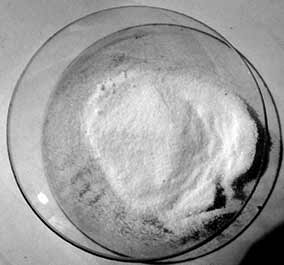About Bromate

Potassium bromate (KBrO3), is a flour "improver" that strengthens dough and allows for greater oven spring and higher rising in the oven. Potassium bromate, commonly referred to as simply "bromate," is a slow-acting oxidizer, contributing its functionality throughout the mixing, fermentation and proofing stages, with important residual action during the early stages of baking. Azodicarbonamide (ADA), potassium and calcium iodate, and calcium peroxide are rapid-acting oxidizers, while ascorbic acid (vitamin C) works at intermediate rates, but all release their activity in mixing and proofing. Bromate, when applied within the prescribed limits (15-30ppm), is completely used up during the bake leaving no trace in the finished product. However, if too much is used, or the bread is not baked long enough or at a high enough temperature, then a residual amount will remain.

The primary concern regarding the use of bromate in baking is its demonstrated link to cancer in laboratory animals. It was first found to induce tumors in rats in 1982. However, instead of banning bromate outright, the FDA has since 1991 merely encouraged bakers to voluntarily stop using it, with somewhat limited success.
Bromate has been banned in numerous countries, including the United Kingdom in 1990 and Canada in 1994. In addition, in 1991, California declared bromate a carcinogen under the state's Proposition 65. As such, baked goods sold in California have to bear a store-level cancer warning if they contain more than a certain level of bromate. As a result, most California bakers have switched to bromate-free processes.
View all bromate informationfrom the California OEHHA.
The California Office of Environmental Health Hazard Assessment (OEHHA) highlights all of the research that led to the addition of potassium bromate to the Prop 65 listing in a document called Chemical Meeting the Criteria for Listing - Bromate.
Flour sold by the King Arthur Flour company has never contained bromate for all of the reasons listed above. If you are a baker who has never used bromated flour then you have nothing to worry about. If you are a baker currently using bromated flours and would like to switch you will have to make some slight adjustments to your mixing process, but in our view the effort is worth it as you will be able to provide your employees a safer working environment, and your customers with a healthier product.
Using Unbromated Flour
The only changes that most bakers find they need to make are slightly longer mixing times. Bromate, as an oxidizer, rapidly strengthens the dough in the mixer bowl, thus reducing mixing times. Doughs made from unbromated flours will require slightly more mixing to achieve the same strength. As you do not want to increase the final temperature of your dough through this additional mixing you must lower your initial water temperature. Those changes should be all that is required by you to make the switch.
Some bakers find that they don't have as much fermentation tolerance using unbromated flour. There are two fixes for this. One is to use preferments in your dough. This increases the acidity of your dough giving it more tolerance for longer proof times and overnight retarding. If this doesn't fit your production requirements then you can consider using ascorbic acid (Vitamin C). Ascorbic acid is a slow acting oxidizer so you won't get much benefit in the mixer, but your dough will have more tolerance for overnight retarding.
We have always felt that baking is much better when you use quality ingredients, and given all of the health risks involved with the use of bromates in bread production, the most important of those ingredients is an unbromated flour.









